

Priory of St. John the Evangelist of the Park of Healaugh
The priory was first established as a hermitage with a gift from Bertram Haget some time before 1160 [Purvis, p. x] It became a priory in 1218 with a gift from Haget's granddaughter, Alice Haget de Sancta Maria.
This is the standard story, but it leaves out a seemingly important contribution to the 1218 reorganization of the priory on the part of Peter de Brus and his men. There are a substantial number of charters involving gifts to the priory at approximately this time. A serious problem in being precise about the timing is the lack of dates on the charters. However, in one of the charters below Joan de Acklam gives land to her brother during the period she is a widow. Joan's first husband died in 1216 and she had remarried by 1220 [A Dame de Boynton: Joan Acklam de Boynton]. Her brother William, in turn, gave the land to the priory. The date of his death is not known, but it is known that he was dead by 1231. In addition, Joan and her new husband, Ingram de Boynton, contributed land to the priory. The connection to Peter de Brus is: 1) he witnessed some of the charters below; 2) the de Acklams had held land from the de Brus family for more than 100 years. The Brus family was instrumental in establishing the priory of Guisborough, and the de Aclkams contributed land to that priory. Here they seem to be doing the same they had done at Guisborough.
These are gifts made by de Acklams and de Boyntons, but there are a number of gifts from others who are also connected to Peter de Brus -- though they are not included below.
There are two major sources of information about the charters of the priory. One is the publication of the chartulary for the priory in 1936, edited by J. S. Purvis. The other is a publication of the estates of the Durham priory in 1872, edited by Greenwell. The summaries of charters below are only the charters that involve the Boyntons in one way or another.
In addition, part of Bulmer's description is included below along with two contemporary pictures of the church.
Boynton interest in the priory does not seem to have lasted particularly long -- perhaps, the two generations Ingram and William. However, they appear to have been there at a critical juncture in the history of the priory.
....
J. S. Purvis, ed. The Chartulary of the Augustinian Priory of St. John the Evangelist of the Park of Healaugh
No. 22. Grant by Engeram de Bovington [to St. John the Evangelist of the park
of Healaugh], of a toft and croft in Marton in Cliveland, bought of William
son of Ahylmer. Witnesses: Henry son of Ralph . . . John de Schalton.
[J. S. Purvis, ed., p. 226.]
Bouceby. [Before A.D. 1310]
Quitclaim and manumission by William de Boynton son of Sir Ingram de Boynton
to God and St. John of the Park of Healaugh and the prior and canons there serving
God, of Roger called the Forester son of William de Scalinge, formerly the grantor's
veillein, with all his chattels and sequel.
[J. S. Purvis, ed., p. 143]
Grant by William de Acclum to Cecilia his daughter, of six acres of land in
Scaling which Roger Ascbrennar held, paying two gilt spurs for 6d. or 6d. to
the chief lord for all service. He has attorned these to acquit ten acres of
land in Aylwynecroft from all service which he gave to God and the blessed Mary
and the house of St. John Evangelist of the Park and the canons there serving
God.
Hiis testibus: Ingeram de Boungton, Henrico filio Radulphi, Roberto de Acclum,
Thoma de Sprydby, et aliis.
[J. S. Purvis, ed., p. 143-144.]
Confirmation by Henry son of Ralph and Agnes his wife, for souls' health, to
God and the Blessed Mary and St. John Evangelist of the Park of Healaugh and
the canons there serving God, of ten acres of land in Schaling which William
son of Roger de Acclum once held of them, free of all service.
Hiis testibus: domino Petro de Brus, Roberto de Acclum, Engeram de Bouington,
et aliis.
[J. S. Purvis, ed., p. 144-145.]
J. S. Purvis, ed. (1936) The Chartulary of the Augustinian Priory of St. John the Evangelist of the Park of Healaugh, Yorkshire Archaeological Society Record Series, vol. XCII.
....
Greenwell, A Survey of the Estates of the Prior and Convent of Durham Compiled in the Fifteenth Century
Joan de Acclum . . . in my widowhood and in my free power, to William, my brother, for his homage and service, the entire moiety of my land, which I had in Cleatlam with the tofts and crofts which Baldwin and Robert, son of Baldwin, and Hugh, son of Jocelin, held . . . rendering yearly for all service and exaction, two gilded spurs or 6d. at the feast of St Cuthbert in September [4 September) . . . With these witnesses, lord Robert son of Meldred, Gilbert Hansard, Brian son of Alan, Gregory de Leuinctorp, William de Bollebi, Robert Bonenfaut, Bernard son of Gilbert, Jordan de Beverle and many others.
William son of Roger de Acclum . . . to God and the Blessed Mary and to the house of St John the Evangelist of [Healaugh] Park and the canons serving God there . . . two bovates of land in the vill and territory of Cleatlam, with all their appurtenances . . . namely, those [bovates] which Baldwin de Cletlum held and Reginald, his son, held of me, with the toft and croft in the aforementioned vill pertaining to the aforesaid two bovates . . . With these witnesses, Alan de Wilton, Ingram de Bouinton, Robert de Acclum, Adam de Hiltone, Robert deacon of Newsham, Walter de Cletlum, Thomas the Scot , Robert son of Adam, and others.
Ingram de Bouintone and Joan, his wife . . . to God and the Blessed Mary and to the house of St John the Evangelist of [Healaugh] Park and the canons there . . . two bovates of land with all appurtenances in the vill and territory of Cleatlam, which they have of the gift of William de Acclum, namely, those two bovates which Reginald, son of Baldwin, held of the aforesaid William de Acclum . . . With these witnesses, Alan de Wiltone, Thomas, his brother, Gregory de Leuint, Robert de Acclum, Walter de Cletlum, Robert clerk of Newsham, and others.
William, son of Ingram de Bouinthona . . . to God and the Blessed Mary and to the house of St John the Evangelist of [Healaugh] Park and the canons there . . . two bovates of land in the vill and territory of Cleatlam, with all their appurtenances . . . namely, those [bovates] which are nearer their two bovates towards the north, which they have of my gift in the same vill, for the exchange of the rent of one mark which they had in the vill of Newbiggin in the Bishopric of Durham . . . With these witnesses, William de Grandun, Alan Petty [or perhaps Little], Henry Spring, Jun de Colevilla, Ellis Burel, Walter de Cletlum and others.
W. Greenwell, ed. (1872) Feodarium Prioratus Dunelmensis, A Survey of the Estates of the Prior and Convent of Durham Compiled in the Fifteenth Century, Publications of the Surtees Society, pp. 154-155.
....
from Bulmer's History and Directory of North Yorkshire (1890)
At an early date, the lands of this parish belonged to the priory of Healaugh park, then established here. We find, from its first charter, that, before 1203, Bertram Haget gave to Gilbert, a monk of Marmonstier, and to his successors, "the lands of the hermitage or desert which is in the wood of Healaugh, viz. that land towards the east, where the water is wont to run and passe from the bridge called Lairbridge, to the passage anciently called Sangneat," to found a religious house. On the site of the hermitage, was built a church, dedicated to St. John the Evangelist, and some religious were stationed here. In or about 1218, a priory of Black Canons was established by Jordan de S. Maria, and Alice, his wife, who was granddaughter to Bertram Haget. Edward II. granted to the prior free warren in all his demesne lands in Healaugh, Wighill, &c. The possessions of the priory lay in the vicinity of the house. At the Dissolution, there were fourteen canons here, with a revenue of £86 5s. 9d. In 1540, the site of the priory came into the possession of James Gage, Esq., who alienated it to Sir Arthur D'Arcy, Knight, after which it became the residence of the Marquis of Wharton. The present proprietor, as was said above, is E. Brooksbank, Esq., and the old manor house, the remains of the priory, is now a farm house
The church, dedicated to St John the Evangelist, stands well on an elevated piece of land, and is of the Norman period. The tower has been rebuilt, probably about the end of the 18th century, and in 1860, the church was restored by the Rev. E. H. Brooksbanks. A new organ has recently been placed in position, at a cost of £210, raised by subscriptions. The edifice consists of a nave, chancel, and north aisles, with a square tower at the west end, containing three bells, and surmounted by a cross. On the south side of the nave, is an arched entrance, of Early Norman workmanship, in good preservation, and consists of four mouldings; the inner one is plain; the second has a series of beaked heads; the third is composed of human heads and figures and masks, of a grotesque pattern; and the fourth one is a chevron moulding. In the chancel aisle is a table monument, of alabaster, bearing the recumbent effigies of a knight, in plain armour, between two ladies, representing Thomas, Lord Wharton, who died in 1568, and his two wives (a duplicate of this monument is to be found at Kirby Stephen, where there is still a Wharton Hall). On the south site of the chancel are memorial windows to members of the Brooksbank family, as well as several tablets on the walls. The handsome brass lectern, the engraving of which is very fine and chaste, was presented by, and is the workmanship of, the present vicar.
http://www.genuki.org.uk/big/eng/YKS/ARY/Healaugh/Healaugh90.html
....
 |
 |
http://www.mondes-normands.caen.fr/france/histoires/5/zoom/pic5-2b.htm